Case Study Analysis: CHCCCS004 Assess Co-existing Needs Assessment
VerifiedAdded on 2023/04/11
|17
|3063
|419
Case Study
AI Summary
This document presents a case study assessment for the CHCCCS004 unit, focusing on assessing co-existing needs within a healthcare context. The assessment includes three scenarios involving an elderly man named Bob and his wife, Nelly, who has dementia. The student is required to answer questions addressing information privacy principles, confidentiality strategies, duty of care, and critical thinking skills in the context of conducting needs assessments. The scenarios also touch upon issues of elder abuse, substance abuse, and mental health concerns, prompting the student to identify reporting requirements and apply analytical skills to evaluate the situation and provide appropriate responses based on the given information. The assessment emphasizes ethical considerations, legal obligations, and the importance of providing appropriate support and care within the healthcare setting.
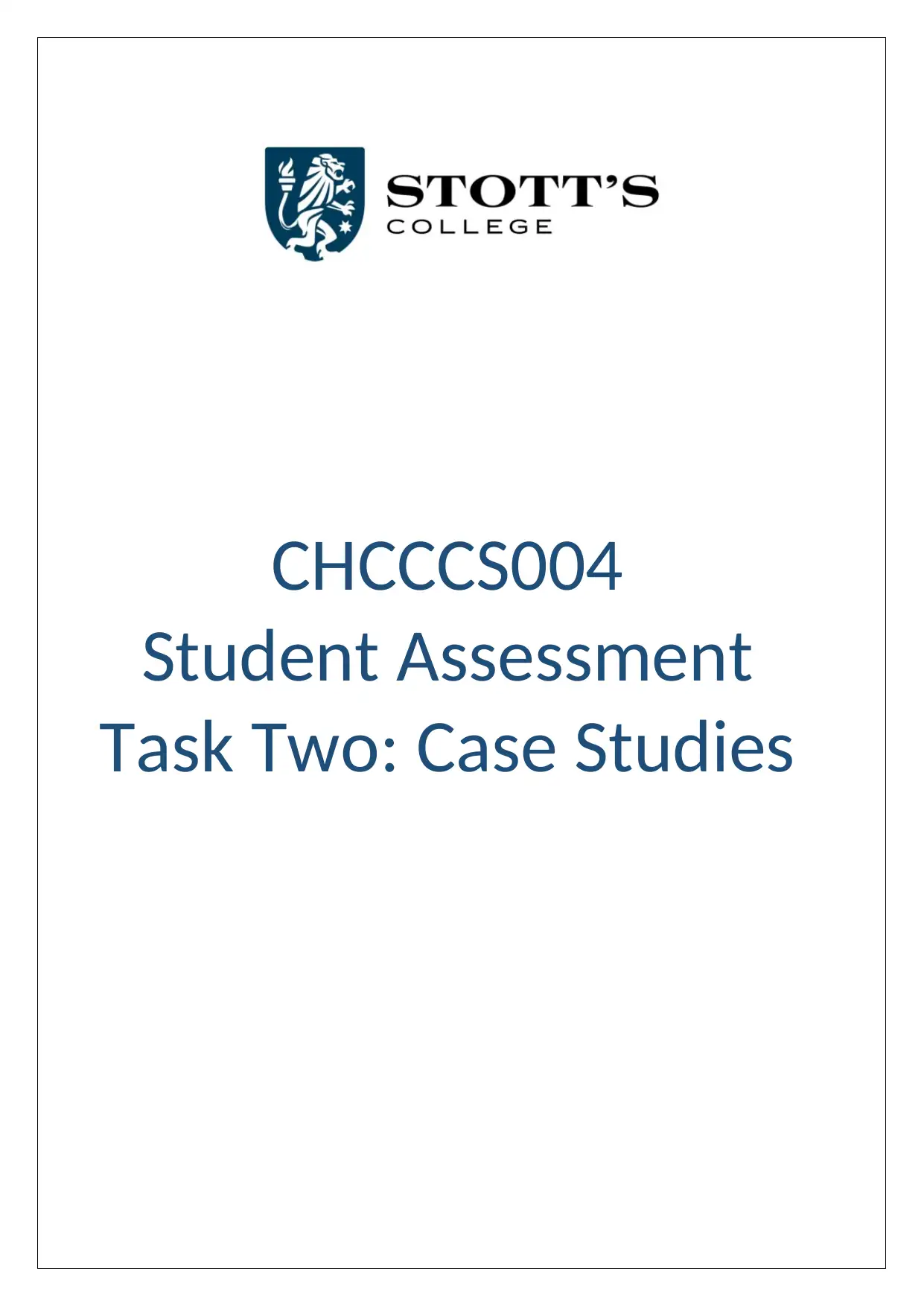
CHCCCS004
Student Assessment
Task Two: Case Studies
Student Assessment
Task Two: Case Studies
Paraphrase This Document
Need a fresh take? Get an instant paraphrase of this document with our AI Paraphraser
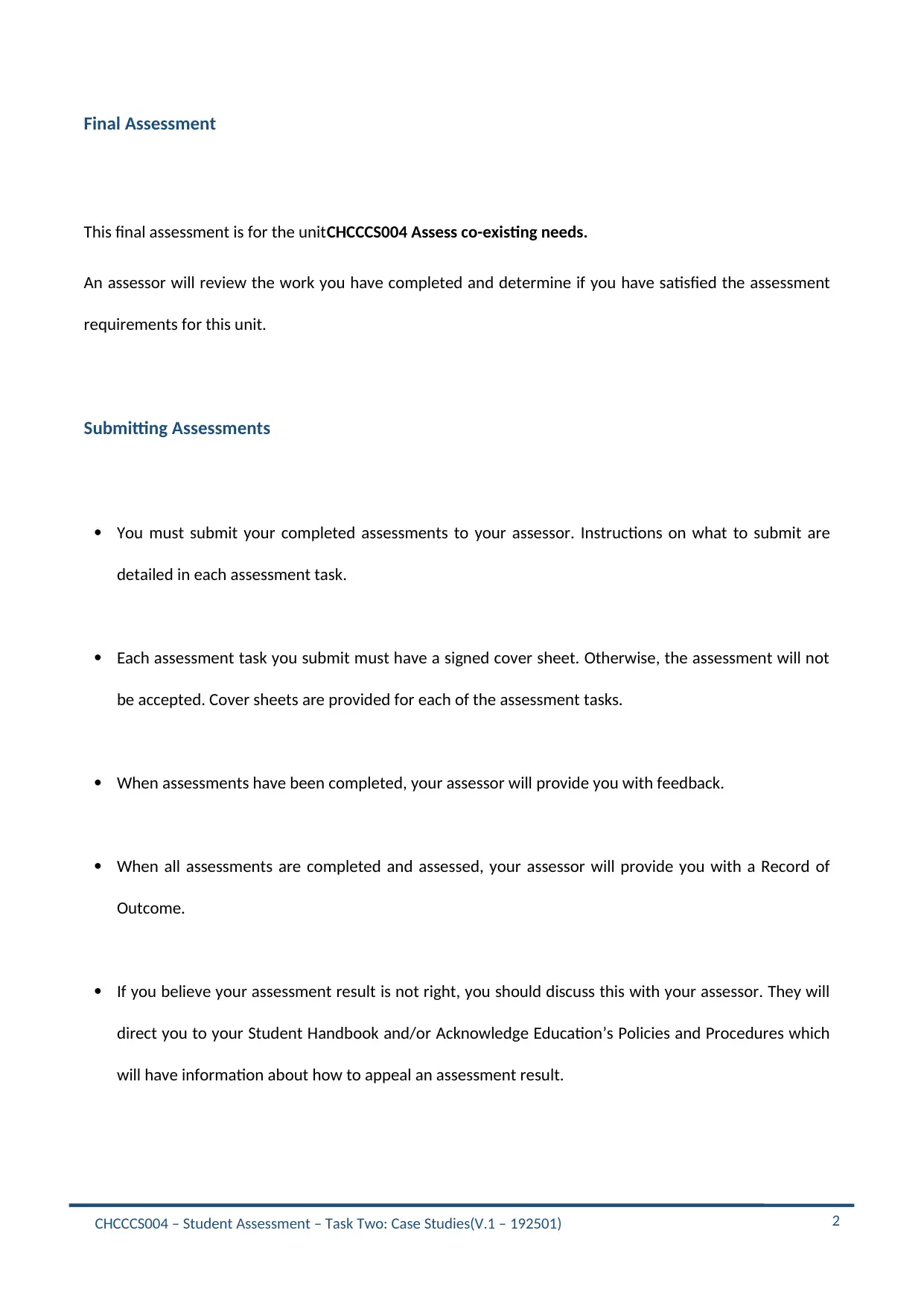
CHCCCS004 – Student Assessment – Task Two: Case Studies(V.1 – 192501)
Final Assessment
This final assessment is for the unitCHCCCS004 Assess co-existing needs.
An assessor will review the work you have completed and determine if you have satisfied the assessment
requirements for this unit.
Submitting Assessments
You must submit your completed assessments to your assessor. Instructions on what to submit are
detailed in each assessment task.
Each assessment task you submit must have a signed cover sheet. Otherwise, the assessment will not
be accepted. Cover sheets are provided for each of the assessment tasks.
When assessments have been completed, your assessor will provide you with feedback.
When all assessments are completed and assessed, your assessor will provide you with a Record of
Outcome.
If you believe your assessment result is not right, you should discuss this with your assessor. They will
direct you to your Student Handbook and/or Acknowledge Education’s Policies and Procedures which
will have information about how to appeal an assessment result.
2
Final Assessment
This final assessment is for the unitCHCCCS004 Assess co-existing needs.
An assessor will review the work you have completed and determine if you have satisfied the assessment
requirements for this unit.
Submitting Assessments
You must submit your completed assessments to your assessor. Instructions on what to submit are
detailed in each assessment task.
Each assessment task you submit must have a signed cover sheet. Otherwise, the assessment will not
be accepted. Cover sheets are provided for each of the assessment tasks.
When assessments have been completed, your assessor will provide you with feedback.
When all assessments are completed and assessed, your assessor will provide you with a Record of
Outcome.
If you believe your assessment result is not right, you should discuss this with your assessor. They will
direct you to your Student Handbook and/or Acknowledge Education’s Policies and Procedures which
will have information about how to appeal an assessment result.
2

CHCCCS004 – Student Assessment – Task Two: Case Studies(V.1 – 192501)
Make sure you read through the document on the following page and understand what the
assessment requires from you before signing the agreement.
Please sign the Assessment Plan and Agreement on the following page, and submit it with your
assessment. Assessments will not be accepted until this signed form is returned to your assessor.
3
Make sure you read through the document on the following page and understand what the
assessment requires from you before signing the agreement.
Please sign the Assessment Plan and Agreement on the following page, and submit it with your
assessment. Assessments will not be accepted until this signed form is returned to your assessor.
3
⊘ This is a preview!⊘
Do you want full access?
Subscribe today to unlock all pages.

Trusted by 1+ million students worldwide

CHCCCS004 – Student Assessment – Task Two: Case Studies(V.1 – 192501)
Assessment Plan and Agreement
Students to “tick” the following statements and sign this agreement:
☐ I agree that the purpose and steps for this assessment have been explained to me.
☐ I have discussed with my trainer/assessor any special needs that I require to complete these
assessments.
☐ My Trainer/assessor has discussed the assessment marking guide with me.
☐ The opportunities to re-attempt the assessment, if required, have been discussed with me.
☐ I understand that I have the right to request for an appeal if I am unsatisfied with the assessment
results.
☐ I have accessed and understood the general assessment information that has been provided to me.
☐ I have been given sufficient time to complete these assessments.
Qualification Title
Unit Code
Unit Title
Student Name
Student ID
Student Email
Student Signature
Date
Assessor Name
Campus ☐Melbourne ☐Sydney ☐Perth
To reach competency in this unit you need to satisfactorily complete the below three assessment tasks.
4
Assessment Plan and Agreement
Students to “tick” the following statements and sign this agreement:
☐ I agree that the purpose and steps for this assessment have been explained to me.
☐ I have discussed with my trainer/assessor any special needs that I require to complete these
assessments.
☐ My Trainer/assessor has discussed the assessment marking guide with me.
☐ The opportunities to re-attempt the assessment, if required, have been discussed with me.
☐ I understand that I have the right to request for an appeal if I am unsatisfied with the assessment
results.
☐ I have accessed and understood the general assessment information that has been provided to me.
☐ I have been given sufficient time to complete these assessments.
Qualification Title
Unit Code
Unit Title
Student Name
Student ID
Student Email
Student Signature
Date
Assessor Name
Campus ☐Melbourne ☐Sydney ☐Perth
To reach competency in this unit you need to satisfactorily complete the below three assessment tasks.
4
Paraphrase This Document
Need a fresh take? Get an instant paraphrase of this document with our AI Paraphraser
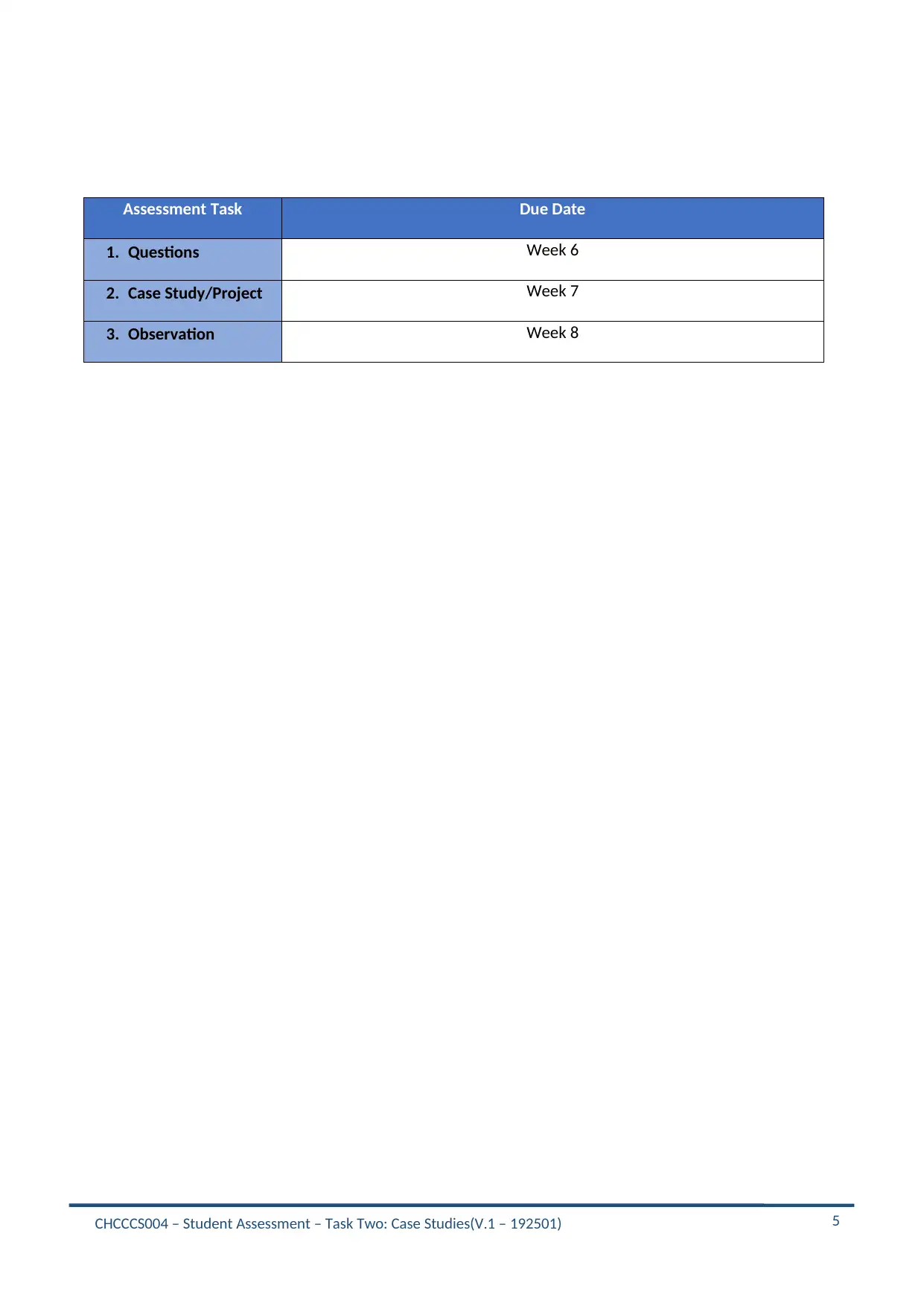
CHCCCS004 – Student Assessment – Task Two: Case Studies(V.1 – 192501)
Assessment Task Due Date
1. Questions Week 6
2. Case Study/Project Week 7
3. Observation Week 8
5
Assessment Task Due Date
1. Questions Week 6
2. Case Study/Project Week 7
3. Observation Week 8
5
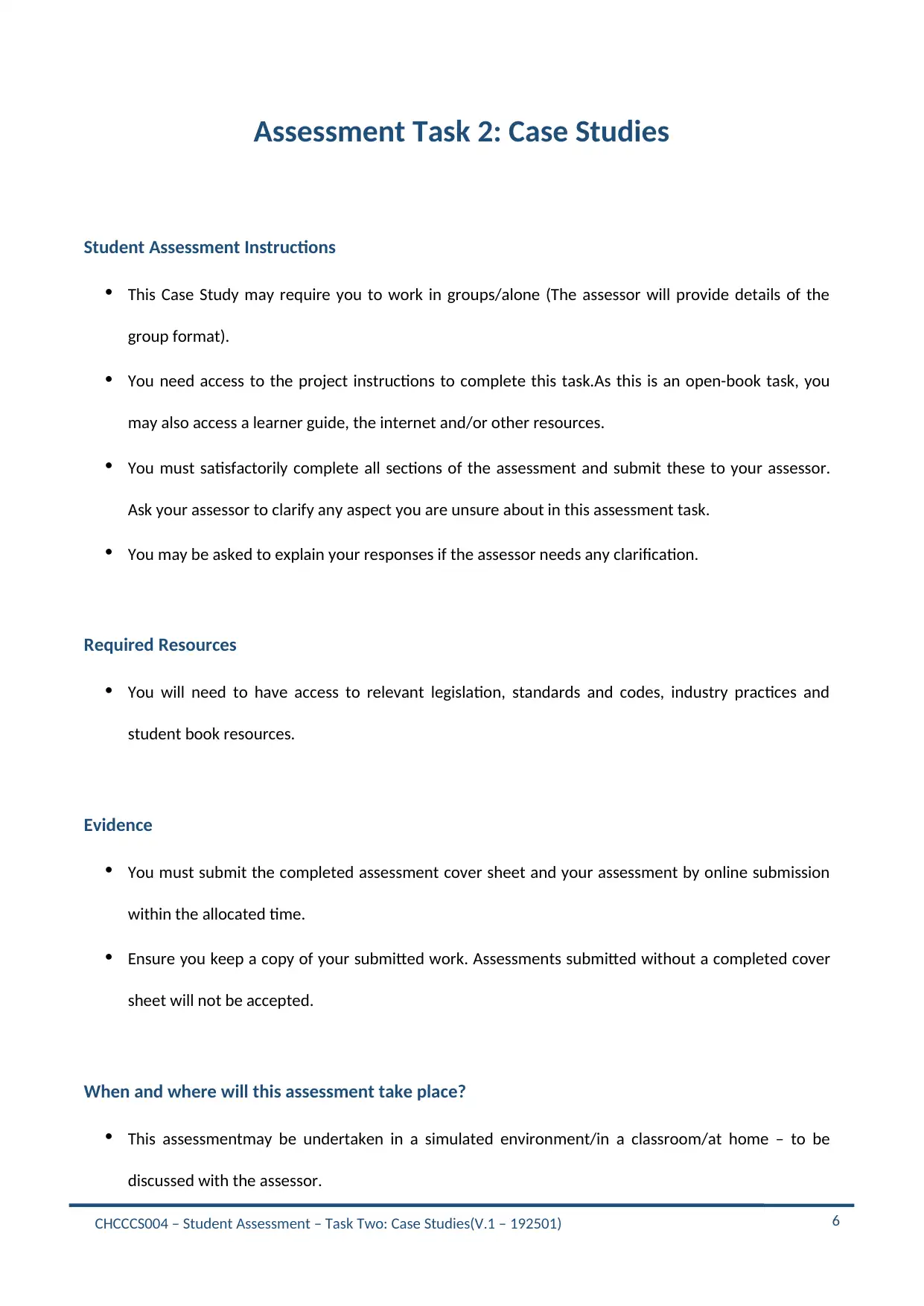
CHCCCS004 – Student Assessment – Task Two: Case Studies(V.1 – 192501)
Assessment Task 2: Case Studies
Student Assessment Instructions
This Case Study may require you to work in groups/alone (The assessor will provide details of the
group format).
You need access to the project instructions to complete this task.As this is an open-book task, you
may also access a learner guide, the internet and/or other resources.
You must satisfactorily complete all sections of the assessment and submit these to your assessor.
Ask your assessor to clarify any aspect you are unsure about in this assessment task.
You may be asked to explain your responses if the assessor needs any clarification.
Required Resources
You will need to have access to relevant legislation, standards and codes, industry practices and
student book resources.
Evidence
You must submit the completed assessment cover sheet and your assessment by online submission
within the allocated time.
Ensure you keep a copy of your submitted work. Assessments submitted without a completed cover
sheet will not be accepted.
When and where will this assessment take place?
This assessmentmay be undertaken in a simulated environment/in a classroom/at home – to be
discussed with the assessor.
6
Assessment Task 2: Case Studies
Student Assessment Instructions
This Case Study may require you to work in groups/alone (The assessor will provide details of the
group format).
You need access to the project instructions to complete this task.As this is an open-book task, you
may also access a learner guide, the internet and/or other resources.
You must satisfactorily complete all sections of the assessment and submit these to your assessor.
Ask your assessor to clarify any aspect you are unsure about in this assessment task.
You may be asked to explain your responses if the assessor needs any clarification.
Required Resources
You will need to have access to relevant legislation, standards and codes, industry practices and
student book resources.
Evidence
You must submit the completed assessment cover sheet and your assessment by online submission
within the allocated time.
Ensure you keep a copy of your submitted work. Assessments submitted without a completed cover
sheet will not be accepted.
When and where will this assessment take place?
This assessmentmay be undertaken in a simulated environment/in a classroom/at home – to be
discussed with the assessor.
6
⊘ This is a preview!⊘
Do you want full access?
Subscribe today to unlock all pages.

Trusted by 1+ million students worldwide
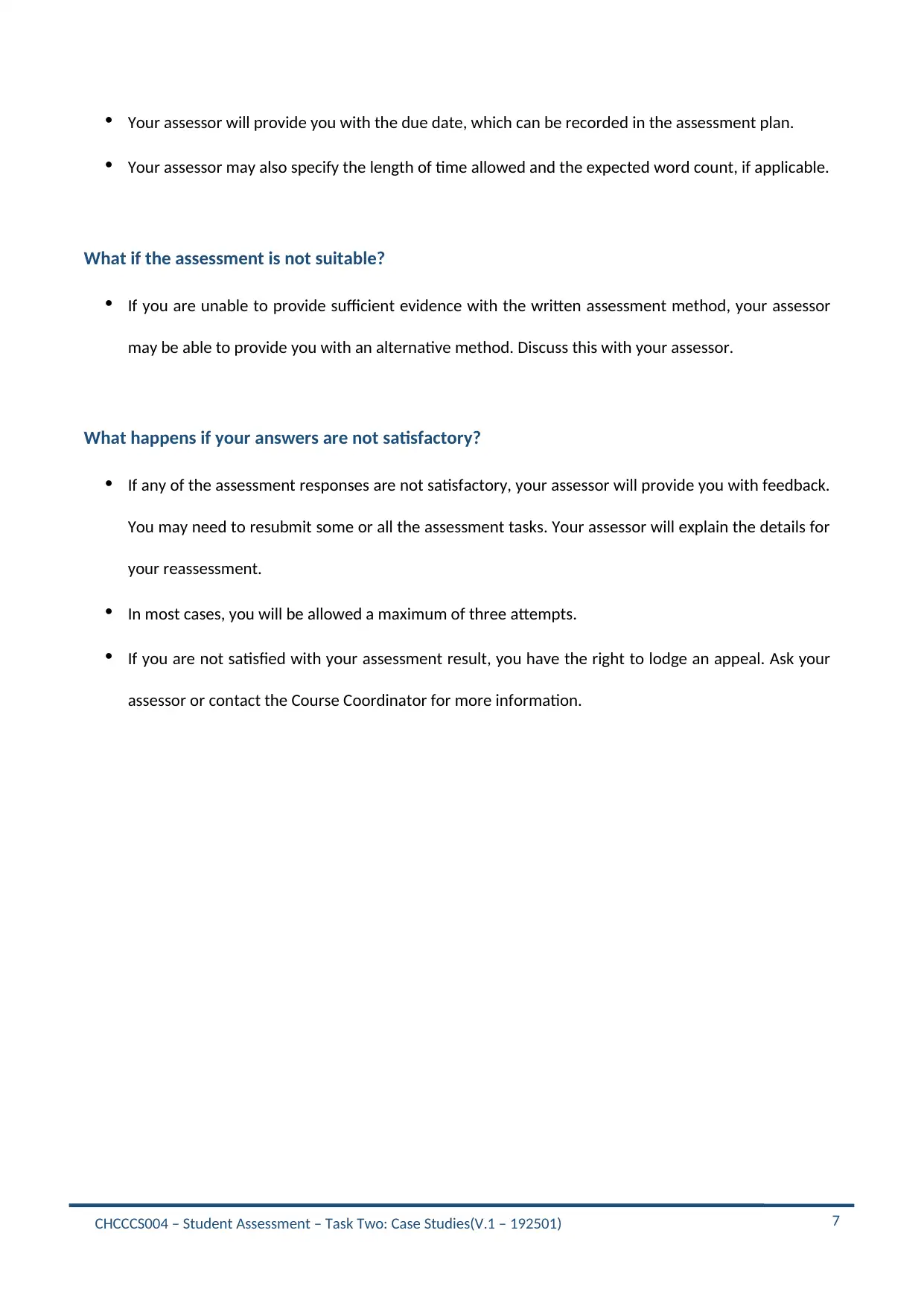
CHCCCS004 – Student Assessment – Task Two: Case Studies(V.1 – 192501)
Your assessor will provide you with the due date, which can be recorded in the assessment plan.
Your assessor may also specify the length of time allowed and the expected word count, if applicable.
What if the assessment is not suitable?
If you are unable to provide sufficient evidence with the written assessment method, your assessor
may be able to provide you with an alternative method. Discuss this with your assessor.
What happens if your answers are not satisfactory?
If any of the assessment responses are not satisfactory, your assessor will provide you with feedback.
You may need to resubmit some or all the assessment tasks. Your assessor will explain the details for
your reassessment.
In most cases, you will be allowed a maximum of three attempts.
If you are not satisfied with your assessment result, you have the right to lodge an appeal. Ask your
assessor or contact the Course Coordinator for more information.
7
Your assessor will provide you with the due date, which can be recorded in the assessment plan.
Your assessor may also specify the length of time allowed and the expected word count, if applicable.
What if the assessment is not suitable?
If you are unable to provide sufficient evidence with the written assessment method, your assessor
may be able to provide you with an alternative method. Discuss this with your assessor.
What happens if your answers are not satisfactory?
If any of the assessment responses are not satisfactory, your assessor will provide you with feedback.
You may need to resubmit some or all the assessment tasks. Your assessor will explain the details for
your reassessment.
In most cases, you will be allowed a maximum of three attempts.
If you are not satisfied with your assessment result, you have the right to lodge an appeal. Ask your
assessor or contact the Course Coordinator for more information.
7
Paraphrase This Document
Need a fresh take? Get an instant paraphrase of this document with our AI Paraphraser
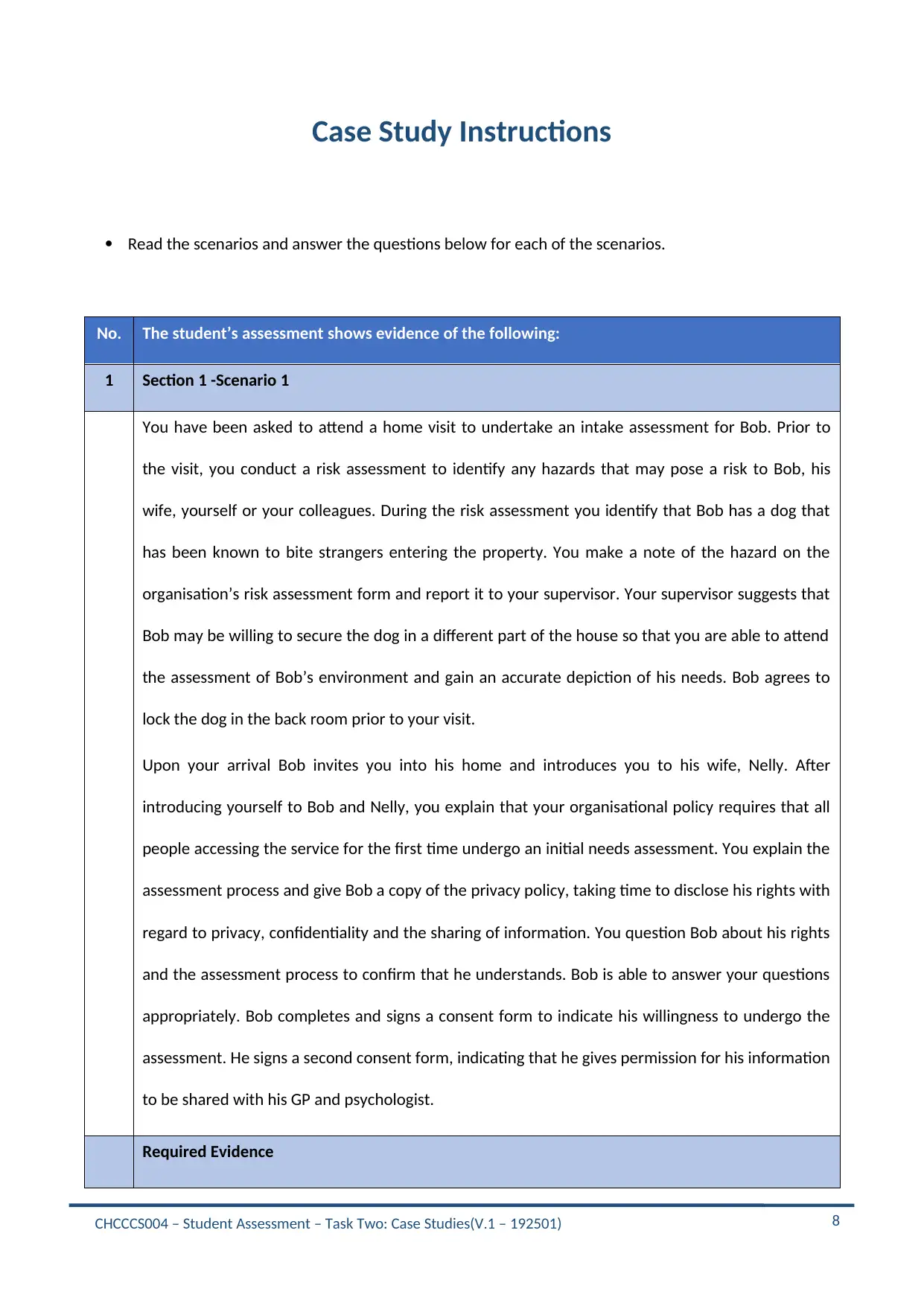
CHCCCS004 – Student Assessment – Task Two: Case Studies(V.1 – 192501)
Case Study Instructions
Read the scenarios and answer the questions below for each of the scenarios.
No. The student’s assessment shows evidence of the following:
1 Section 1 -Scenario 1
You have been asked to attend a home visit to undertake an intake assessment for Bob. Prior to
the visit, you conduct a risk assessment to identify any hazards that may pose a risk to Bob, his
wife, yourself or your colleagues. During the risk assessment you identify that Bob has a dog that
has been known to bite strangers entering the property. You make a note of the hazard on the
organisation’s risk assessment form and report it to your supervisor. Your supervisor suggests that
Bob may be willing to secure the dog in a different part of the house so that you are able to attend
the assessment of Bob’s environment and gain an accurate depiction of his needs. Bob agrees to
lock the dog in the back room prior to your visit.
Upon your arrival Bob invites you into his home and introduces you to his wife, Nelly. After
introducing yourself to Bob and Nelly, you explain that your organisational policy requires that all
people accessing the service for the first time undergo an initial needs assessment. You explain the
assessment process and give Bob a copy of the privacy policy, taking time to disclose his rights with
regard to privacy, confidentiality and the sharing of information. You question Bob about his rights
and the assessment process to confirm that he understands. Bob is able to answer your questions
appropriately. Bob completes and signs a consent form to indicate his willingness to undergo the
assessment. He signs a second consent form, indicating that he gives permission for his information
to be shared with his GP and psychologist.
Required Evidence
8
Case Study Instructions
Read the scenarios and answer the questions below for each of the scenarios.
No. The student’s assessment shows evidence of the following:
1 Section 1 -Scenario 1
You have been asked to attend a home visit to undertake an intake assessment for Bob. Prior to
the visit, you conduct a risk assessment to identify any hazards that may pose a risk to Bob, his
wife, yourself or your colleagues. During the risk assessment you identify that Bob has a dog that
has been known to bite strangers entering the property. You make a note of the hazard on the
organisation’s risk assessment form and report it to your supervisor. Your supervisor suggests that
Bob may be willing to secure the dog in a different part of the house so that you are able to attend
the assessment of Bob’s environment and gain an accurate depiction of his needs. Bob agrees to
lock the dog in the back room prior to your visit.
Upon your arrival Bob invites you into his home and introduces you to his wife, Nelly. After
introducing yourself to Bob and Nelly, you explain that your organisational policy requires that all
people accessing the service for the first time undergo an initial needs assessment. You explain the
assessment process and give Bob a copy of the privacy policy, taking time to disclose his rights with
regard to privacy, confidentiality and the sharing of information. You question Bob about his rights
and the assessment process to confirm that he understands. Bob is able to answer your questions
appropriately. Bob completes and signs a consent form to indicate his willingness to undergo the
assessment. He signs a second consent form, indicating that he gives permission for his information
to be shared with his GP and psychologist.
Required Evidence
8
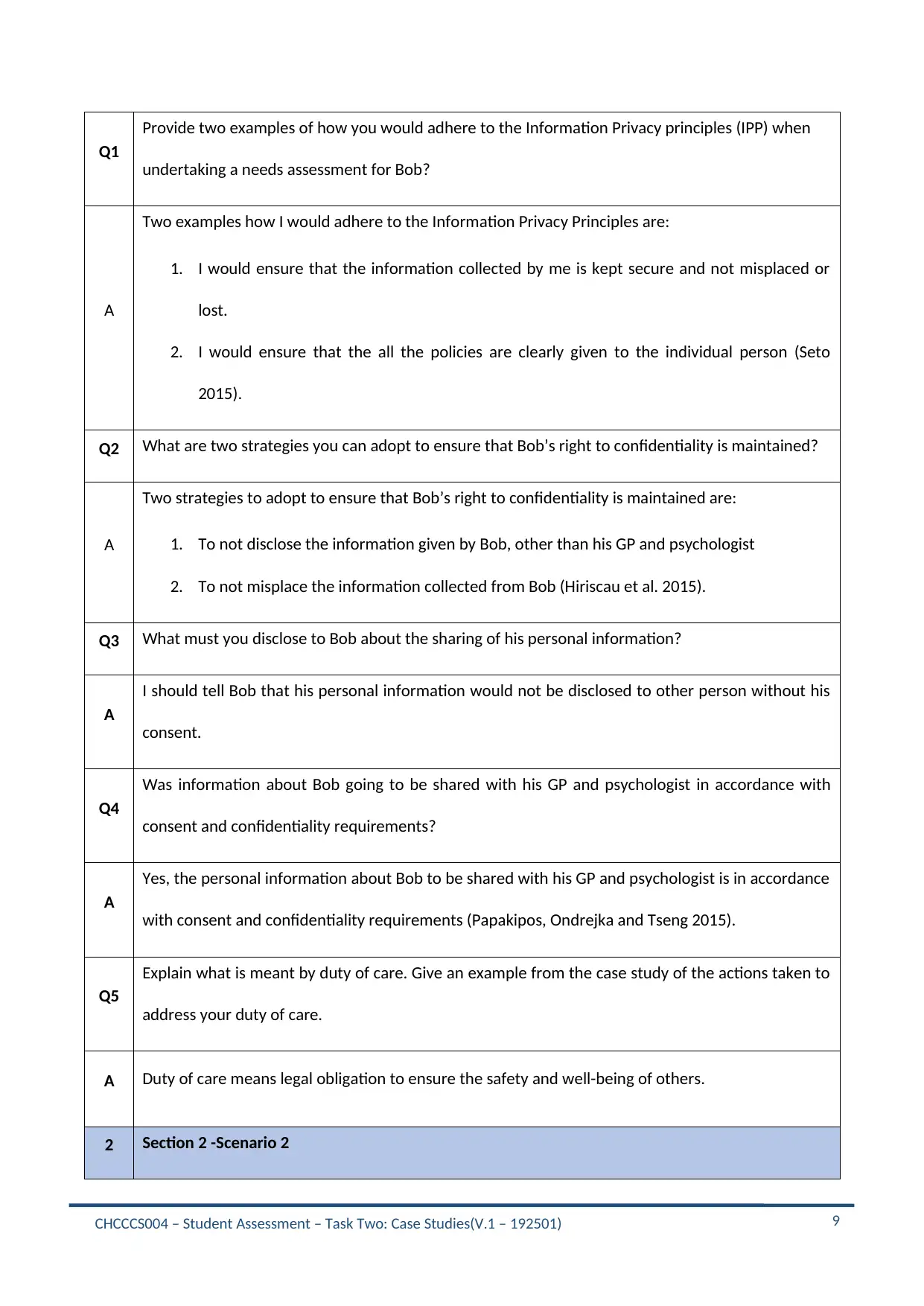
CHCCCS004 – Student Assessment – Task Two: Case Studies(V.1 – 192501)
Q1
Provide two examples of how you would adhere to the Information Privacy principles (IPP) when
undertaking a needs assessment for Bob?
A
Two examples how I would adhere to the Information Privacy Principles are:
1. I would ensure that the information collected by me is kept secure and not misplaced or
lost.
2. I would ensure that the all the policies are clearly given to the individual person (Seto
2015).
Q2 What are two strategies you can adopt to ensure that Bob’s right to confidentiality is maintained?
A
Two strategies to adopt to ensure that Bob’s right to confidentiality is maintained are:
1. To not disclose the information given by Bob, other than his GP and psychologist
2. To not misplace the information collected from Bob (Hiriscau et al. 2015).
Q3 What must you disclose to Bob about the sharing of his personal information?
A
I should tell Bob that his personal information would not be disclosed to other person without his
consent.
Q4
Was information about Bob going to be shared with his GP and psychologist in accordance with
consent and confidentiality requirements?
A
Yes, the personal information about Bob to be shared with his GP and psychologist is in accordance
with consent and confidentiality requirements (Papakipos, Ondrejka and Tseng 2015).
Q5
Explain what is meant by duty of care. Give an example from the case study of the actions taken to
address your duty of care.
A Duty of care means legal obligation to ensure the safety and well-being of others.
2 Section 2 -Scenario 2
9
Q1
Provide two examples of how you would adhere to the Information Privacy principles (IPP) when
undertaking a needs assessment for Bob?
A
Two examples how I would adhere to the Information Privacy Principles are:
1. I would ensure that the information collected by me is kept secure and not misplaced or
lost.
2. I would ensure that the all the policies are clearly given to the individual person (Seto
2015).
Q2 What are two strategies you can adopt to ensure that Bob’s right to confidentiality is maintained?
A
Two strategies to adopt to ensure that Bob’s right to confidentiality is maintained are:
1. To not disclose the information given by Bob, other than his GP and psychologist
2. To not misplace the information collected from Bob (Hiriscau et al. 2015).
Q3 What must you disclose to Bob about the sharing of his personal information?
A
I should tell Bob that his personal information would not be disclosed to other person without his
consent.
Q4
Was information about Bob going to be shared with his GP and psychologist in accordance with
consent and confidentiality requirements?
A
Yes, the personal information about Bob to be shared with his GP and psychologist is in accordance
with consent and confidentiality requirements (Papakipos, Ondrejka and Tseng 2015).
Q5
Explain what is meant by duty of care. Give an example from the case study of the actions taken to
address your duty of care.
A Duty of care means legal obligation to ensure the safety and well-being of others.
2 Section 2 -Scenario 2
9
⊘ This is a preview!⊘
Do you want full access?
Subscribe today to unlock all pages.

Trusted by 1+ million students worldwide
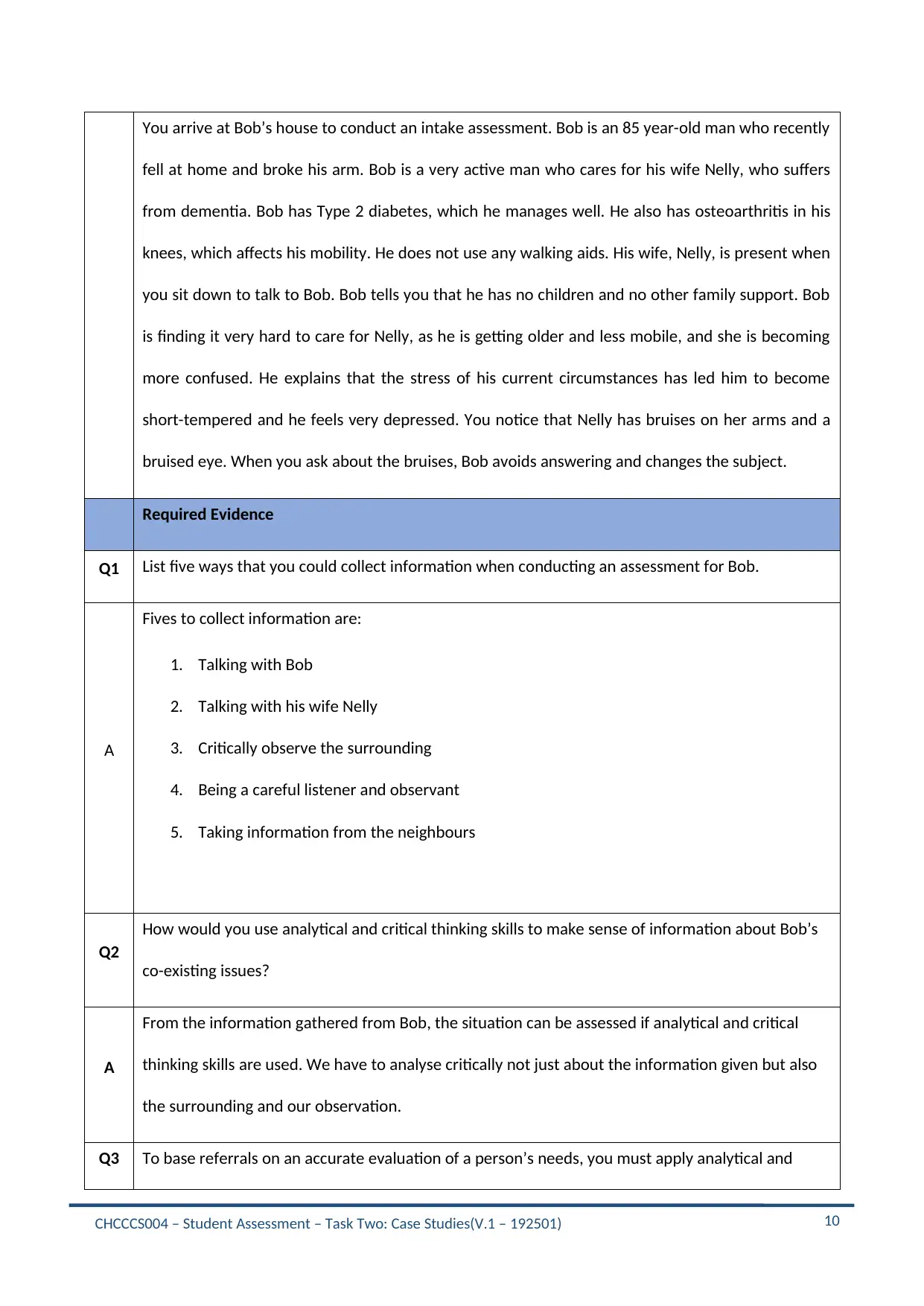
CHCCCS004 – Student Assessment – Task Two: Case Studies(V.1 – 192501)
You arrive at Bob’s house to conduct an intake assessment. Bob is an 85 year-old man who recently
fell at home and broke his arm. Bob is a very active man who cares for his wife Nelly, who suffers
from dementia. Bob has Type 2 diabetes, which he manages well. He also has osteoarthritis in his
knees, which affects his mobility. He does not use any walking aids. His wife, Nelly, is present when
you sit down to talk to Bob. Bob tells you that he has no children and no other family support. Bob
is finding it very hard to care for Nelly, as he is getting older and less mobile, and she is becoming
more confused. He explains that the stress of his current circumstances has led him to become
short-tempered and he feels very depressed. You notice that Nelly has bruises on her arms and a
bruised eye. When you ask about the bruises, Bob avoids answering and changes the subject.
Required Evidence
Q1 List five ways that you could collect information when conducting an assessment for Bob.
A
Fives to collect information are:
1. Talking with Bob
2. Talking with his wife Nelly
3. Critically observe the surrounding
4. Being a careful listener and observant
5. Taking information from the neighbours
Q2
How would you use analytical and critical thinking skills to make sense of information about Bob’s
co-existing issues?
A
From the information gathered from Bob, the situation can be assessed if analytical and critical
thinking skills are used. We have to analyse critically not just about the information given but also
the surrounding and our observation.
Q3 To base referrals on an accurate evaluation of a person’s needs, you must apply analytical and
10
You arrive at Bob’s house to conduct an intake assessment. Bob is an 85 year-old man who recently
fell at home and broke his arm. Bob is a very active man who cares for his wife Nelly, who suffers
from dementia. Bob has Type 2 diabetes, which he manages well. He also has osteoarthritis in his
knees, which affects his mobility. He does not use any walking aids. His wife, Nelly, is present when
you sit down to talk to Bob. Bob tells you that he has no children and no other family support. Bob
is finding it very hard to care for Nelly, as he is getting older and less mobile, and she is becoming
more confused. He explains that the stress of his current circumstances has led him to become
short-tempered and he feels very depressed. You notice that Nelly has bruises on her arms and a
bruised eye. When you ask about the bruises, Bob avoids answering and changes the subject.
Required Evidence
Q1 List five ways that you could collect information when conducting an assessment for Bob.
A
Fives to collect information are:
1. Talking with Bob
2. Talking with his wife Nelly
3. Critically observe the surrounding
4. Being a careful listener and observant
5. Taking information from the neighbours
Q2
How would you use analytical and critical thinking skills to make sense of information about Bob’s
co-existing issues?
A
From the information gathered from Bob, the situation can be assessed if analytical and critical
thinking skills are used. We have to analyse critically not just about the information given but also
the surrounding and our observation.
Q3 To base referrals on an accurate evaluation of a person’s needs, you must apply analytical and
10
Paraphrase This Document
Need a fresh take? Get an instant paraphrase of this document with our AI Paraphraser
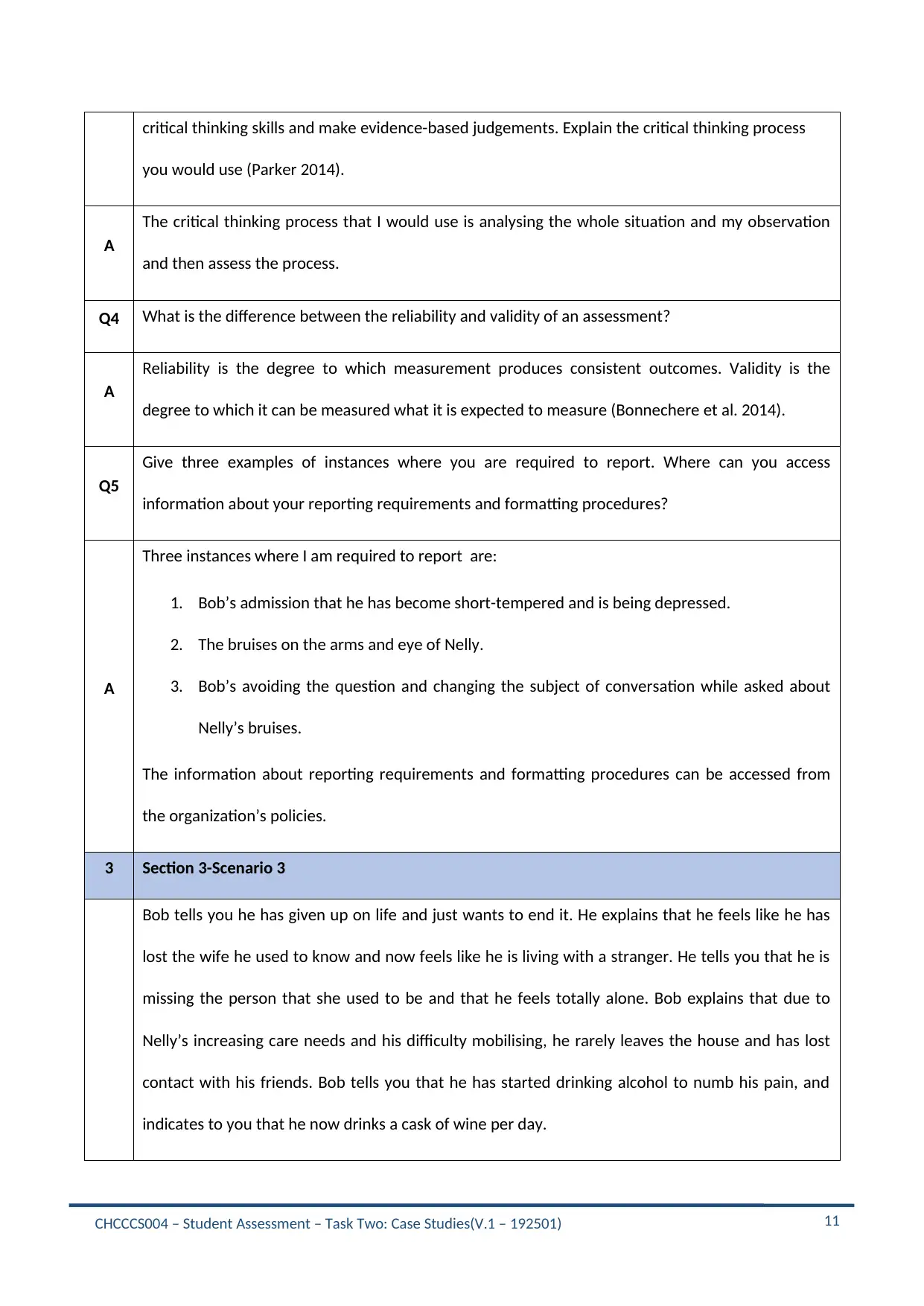
CHCCCS004 – Student Assessment – Task Two: Case Studies(V.1 – 192501)
critical thinking skills and make evidence-based judgements. Explain the critical thinking process
you would use (Parker 2014).
A
The critical thinking process that I would use is analysing the whole situation and my observation
and then assess the process.
Q4 What is the difference between the reliability and validity of an assessment?
A
Reliability is the degree to which measurement produces consistent outcomes. Validity is the
degree to which it can be measured what it is expected to measure (Bonnechere et al. 2014).
Q5
Give three examples of instances where you are required to report. Where can you access
information about your reporting requirements and formatting procedures?
A
Three instances where I am required to report are:
1. Bob’s admission that he has become short-tempered and is being depressed.
2. The bruises on the arms and eye of Nelly.
3. Bob’s avoiding the question and changing the subject of conversation while asked about
Nelly’s bruises.
The information about reporting requirements and formatting procedures can be accessed from
the organization’s policies.
3 Section 3-Scenario 3
Bob tells you he has given up on life and just wants to end it. He explains that he feels like he has
lost the wife he used to know and now feels like he is living with a stranger. He tells you that he is
missing the person that she used to be and that he feels totally alone. Bob explains that due to
Nelly’s increasing care needs and his difficulty mobilising, he rarely leaves the house and has lost
contact with his friends. Bob tells you that he has started drinking alcohol to numb his pain, and
indicates to you that he now drinks a cask of wine per day.
11
critical thinking skills and make evidence-based judgements. Explain the critical thinking process
you would use (Parker 2014).
A
The critical thinking process that I would use is analysing the whole situation and my observation
and then assess the process.
Q4 What is the difference between the reliability and validity of an assessment?
A
Reliability is the degree to which measurement produces consistent outcomes. Validity is the
degree to which it can be measured what it is expected to measure (Bonnechere et al. 2014).
Q5
Give three examples of instances where you are required to report. Where can you access
information about your reporting requirements and formatting procedures?
A
Three instances where I am required to report are:
1. Bob’s admission that he has become short-tempered and is being depressed.
2. The bruises on the arms and eye of Nelly.
3. Bob’s avoiding the question and changing the subject of conversation while asked about
Nelly’s bruises.
The information about reporting requirements and formatting procedures can be accessed from
the organization’s policies.
3 Section 3-Scenario 3
Bob tells you he has given up on life and just wants to end it. He explains that he feels like he has
lost the wife he used to know and now feels like he is living with a stranger. He tells you that he is
missing the person that she used to be and that he feels totally alone. Bob explains that due to
Nelly’s increasing care needs and his difficulty mobilising, he rarely leaves the house and has lost
contact with his friends. Bob tells you that he has started drinking alcohol to numb his pain, and
indicates to you that he now drinks a cask of wine per day.
11
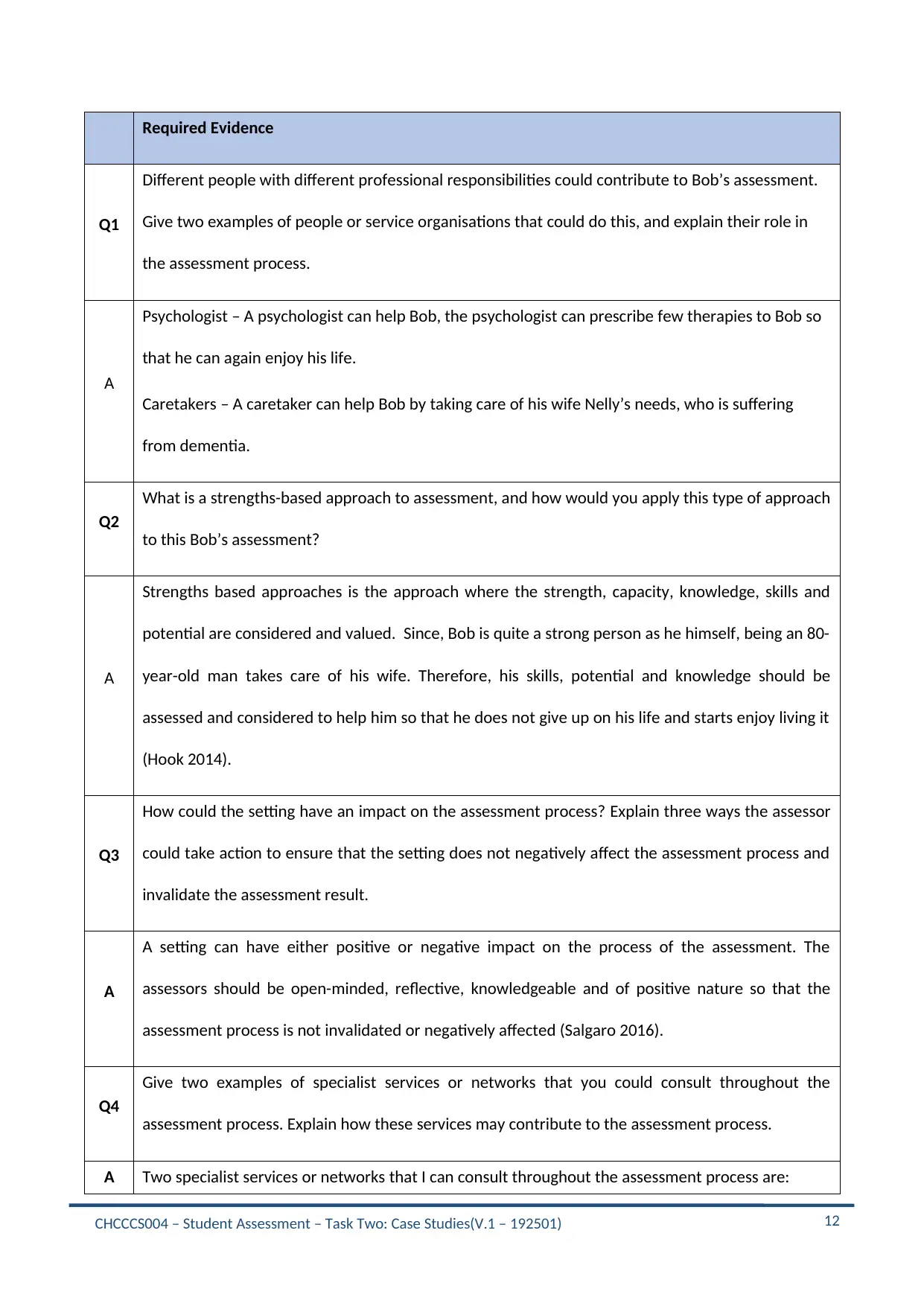
CHCCCS004 – Student Assessment – Task Two: Case Studies(V.1 – 192501)
Required Evidence
Q1
Different people with different professional responsibilities could contribute to Bob’s assessment.
Give two examples of people or service organisations that could do this, and explain their role in
the assessment process.
A
Psychologist – A psychologist can help Bob, the psychologist can prescribe few therapies to Bob so
that he can again enjoy his life.
Caretakers – A caretaker can help Bob by taking care of his wife Nelly’s needs, who is suffering
from dementia.
Q2
What is a strengths-based approach to assessment, and how would you apply this type of approach
to this Bob’s assessment?
A
Strengths based approaches is the approach where the strength, capacity, knowledge, skills and
potential are considered and valued. Since, Bob is quite a strong person as he himself, being an 80-
year-old man takes care of his wife. Therefore, his skills, potential and knowledge should be
assessed and considered to help him so that he does not give up on his life and starts enjoy living it
(Hook 2014).
Q3
How could the setting have an impact on the assessment process? Explain three ways the assessor
could take action to ensure that the setting does not negatively affect the assessment process and
invalidate the assessment result.
A
A setting can have either positive or negative impact on the process of the assessment. The
assessors should be open-minded, reflective, knowledgeable and of positive nature so that the
assessment process is not invalidated or negatively affected (Salgaro 2016).
Q4
Give two examples of specialist services or networks that you could consult throughout the
assessment process. Explain how these services may contribute to the assessment process.
A Two specialist services or networks that I can consult throughout the assessment process are:
12
Required Evidence
Q1
Different people with different professional responsibilities could contribute to Bob’s assessment.
Give two examples of people or service organisations that could do this, and explain their role in
the assessment process.
A
Psychologist – A psychologist can help Bob, the psychologist can prescribe few therapies to Bob so
that he can again enjoy his life.
Caretakers – A caretaker can help Bob by taking care of his wife Nelly’s needs, who is suffering
from dementia.
Q2
What is a strengths-based approach to assessment, and how would you apply this type of approach
to this Bob’s assessment?
A
Strengths based approaches is the approach where the strength, capacity, knowledge, skills and
potential are considered and valued. Since, Bob is quite a strong person as he himself, being an 80-
year-old man takes care of his wife. Therefore, his skills, potential and knowledge should be
assessed and considered to help him so that he does not give up on his life and starts enjoy living it
(Hook 2014).
Q3
How could the setting have an impact on the assessment process? Explain three ways the assessor
could take action to ensure that the setting does not negatively affect the assessment process and
invalidate the assessment result.
A
A setting can have either positive or negative impact on the process of the assessment. The
assessors should be open-minded, reflective, knowledgeable and of positive nature so that the
assessment process is not invalidated or negatively affected (Salgaro 2016).
Q4
Give two examples of specialist services or networks that you could consult throughout the
assessment process. Explain how these services may contribute to the assessment process.
A Two specialist services or networks that I can consult throughout the assessment process are:
12
⊘ This is a preview!⊘
Do you want full access?
Subscribe today to unlock all pages.

Trusted by 1+ million students worldwide
1 out of 17
Related Documents
Your All-in-One AI-Powered Toolkit for Academic Success.
+13062052269
info@desklib.com
Available 24*7 on WhatsApp / Email
![[object Object]](/_next/static/media/star-bottom.7253800d.svg)
Unlock your academic potential
Copyright © 2020–2025 A2Z Services. All Rights Reserved. Developed and managed by ZUCOL.





